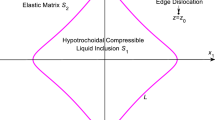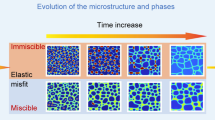Abstract
The sensitivity of the mechanical properties of materials to violations of the translational invariance of the crystal lattice makes it possible to manipulate these properties in the desired direction by doping or creating solid solutions. In this paper, we theoretically study the mechanisms of such manipulation in relation to materials in which the dislocation mobility is controlled mainly by the potential relief of the crystal lattice, the so-called Peierls relief. Due to the concentration of alloying atoms in dislocation nuclei, which play the role of traps for these atoms, the dynamic properties of the dislocations change, which also leads to modification of the macroscopic mechanical properties of the material. The theory of the doping effect on the kink mechanism for overcoming the Peierls barriers is constructed taking into account the disordered content of solution atoms in dislocation nuclei. In this case, the direct description of the kinetics of elementary processes characteristic of kinks is replaced by a statistical description. The multidirectional effect of fluctuations in the distribution of solution atoms, which increase the frequency of the formation of kink pairs but hinder the propagation of kinks along dislocation lines, is considered. The inhibition of kinks can lead to an anomalous character of their mobility, called quasi-localization. The conditions for the predominance of an accelerating or decelerating factor that correspond in macroscopic terms to hardening or softening of the material are found.




Similar content being viewed by others
REFERENCES
E. Pink and R. J. Arsenault, Prog. Mater. Sci. 24, 1 (1979).
P. Astie, J. P. Peyrade, and P. Groh, Scr. Metall. 16, 977 (1982).
D. Caillard, Acta Mater. 61, 2793 (2013).
P. Chomel and J. P. Cottu, Acta Mater. 30, 1481 (1982).
C. Gupta, Phys. Status Solidi A 206, 685 (2009). https://doi.org/10.1002/pssa.200824289
Y.-J. Hu, M. R. Fellinger, B. G. Butler, J. D. Paramore, J. P. Ligda, Ren. Chai, Z. Z. Fang, S. C. Middlemas, and K. J. Hemker, Int. J. Refract. Met. Hard Mater. 75, 248 (2018). https://doi.org/10.1016/j.ijrmhm.2018.04.021
K. Okazaki, J. Mater. Sci. 31, 1087 (1996).
P. I. Raffo, J. Less-Common Met. 17, 133 (1968).
L. Romaner and C. Ambrosch-Draxl, Phys. Rev. Lett. 104, 195503 (2010). https://doi.org/10.1103/PhysRevLett.104.195503
Y. Zhao and J. Marian, Model. Simul. Mater. Sci. Eng. 26, 045002 (2018). https://doi.org/10.1088/1361-65Xaaaecf
A. Vaid, D. Wei, E. Bitzek, S. Nasiri, and M. Zaiser, Acta Mater. 236, 118095 (2022). https://doi.org/10.1016/j.actamat.2022.118095
G. D. Samolyuk, Y. N. Osetsky, and R. E. Stoller, J. Phys.: Condens. Matter 25, 025403 (2012). https://doi.org/10.1088/0953-8984/25/2/025403
G. Hachet, D. Caillard, L. Ventelon, and E. Clouet, Acta Mater. 222, 117440 (2022). https://doi.org/10.1016/j.actamat.2021.117440
O. Barrera, D. Bombac, Y. Chen, T. D. Daff, E. Galindo-Nava, P. Gong, D. Haley, R. Horton, I. Katzarov, J. R. Kermode, C. Liverani, M. Stopher, and F. Sweeney, J. Mater. Sci. 53, 6251 (2018). https://doi.org/10.1007/s10853-017-1978-5
B. V. Petukhov, Bull. Russ. Acad. Sci.: Phys. 86, 1253 (2022). https://doi.org/10.3103/S106287382210015X
P. Guyot and J. E. Dorn, Can. J. Phys. 45, 983 (1967).
E. Nadgorny, Prog. Mater. Sci. 31, 1 (1988).
A. Seeger, Mater. Sci. Eng., A 370, 50 (2004).
P. Gong, I. H. Katzarov, J. Nutter, A. T. Paxton, and W. M. Rainforth, Sci. Rep. 10, 10209 (2020). https//doi.org/https://doi.org/10.1038/s41598-020-66965-z
U. Messerschmidt, Dislocation Dynamics During Plastic Deformation, Springer Series in Material Science, Ed. by R. Hull, C. Jagadish, Y. Kawazoe, et al. (Springer, Heidelberg, 2010). https://doi.org/10.1007/978-3-642-03177-9
D. Caillard and J. L. Martin, Thermally Activated Mechanisms in Crystal Plastisity (Pergamon, Amsterdam, 2003).
B. V. Petukhov, Dislocation Dynamics in Crystalline Relief: Dislocation Kinks and Plasticity of Crystalline Materials (LAP, Saarbrucken, 2016) [in Russian].
H. Koizumi, H. O. K. Kirchner, and T. Suzuki, Philos. Mag. A 69, 895 (1994).
A. H. W. Ngan, Philos. Mag. A 79, 1687 (1999). https://doi.org/10.1080/01418619908210387
H. Mori, Mater. Trans. 55, 1531 (2014).
J. P. Hirth and J. Lothe, Theory of Dislocations (McGraw-Hill, New York, 1968; Atomizdat, Moscow, 1972).
I. H. Katzarov and L. B. Drenchev, Crystals 12, 518 (2022). https://doi.org/10.3390/cryst12040518
B. V. Petukhov, Fiz. Met. Metalloved. 56, 1177 (1983).
M. Wen, S. Fukuyama, and K. Yokogawa, Acta Mater. 51, 1767 (2003).
Y. Wang, X. Wang, Q. Li, B. Xu, and W. Liu, J. Mater. Sci. 54, 10728 (2019). https://doi.org/10.1007/s10853-019-03564-y
B. V. Petukhov, J. Surf. Invest.: X-ray, Synchrotron Neutron Tech. 16, 86 (2022). https://doi.org/10.1134/S1027451022010141
I. H. Katzarov, L. B. Drenchev, D. L. Pashov, T. N. A. T. Zarrouk, O. Al-lahham, and A. T. Paxton, Phys. Rev. Mater. 6, 063603 (2022). https://doi.org/10.1103/PhyRevMaterials.6.063603
L. D. Landau and E. M. Lifshits, Statistical Physics (Fizmatlit, Moscow, 2004) [in Russian].
I. M. Lifshits, S. A. Gredeskul, and L. A. Pastur, Introduction to the Theory of Disordered Systems (Nauka, Moscow, 1982) [in Russian].
B. V. Petukhov, J. Exp. Theor. Phys. 110, 41 (2010).
F. Maresca and W. A. Curtin, Acta Mater. 162, 144 (2020). https://doi.org/10.1016/j.actamat.2019.10.007
H. Suzuki, in Dislocations in Solids, Vol. 4, Ed. by F. R. Nabarro (North Holland, Amsterdam, 1980), p. 191.
E. Antillon, C. Woodward, S. I. Rao, and B. Akdim, Acta Mater. 215, 117012 (2021).
B. V. Petukhov, Fiz. Tverd. Tela 30, 2893 (1988).
S. Foss, D. Korshunov, and S. Zachary, An Introduction To Heavy-Tailed and Subexponential Distributions (Springer, New York, 2011). https://doi.org/10.1007/978-1-4419-9473-8
Yu. L. Iunin, V. I. Nikitenko, V. I. Orlov, and B. V. Petukhov, Phys. Rev. Lett. 78, 3137 (1997). https://doi.org/10.1103/PhysRevLett.78.3137
J.-P. Bouchaud and A. Georges, Phys. Rep. 195, 127 (1990). https://doi.org/10.1016/0370-1573(90)90099-N
V. V. Uchaikin, Phys.—Usp. 46, 821 (2003). https://doi.org/10.1070/PU2003v046n08ABEH001324
B. V. Petukhov, Fiz. Tverd. Tela 32, 1121 (1993). https://doi.org/10.3367/UFNr.0173.200308c.0847
B. V. Petukhov, Fiz. Tverd. Tela 64, 1972 (2022). https://doi.org/10.21883/FTT.2022/53651.450
A. Ghafarollahi and W. Curtin, Acta Mater. 215, 117078 (2021). https;//doi.org/j.actamat.2921.117o78
D. Caillard, Acta Mater. 59, 4974 (2011). https://doi.org/10.1016/j.actamat.2011.04.048
D. Caillard, Acta Mater. 112, 273 (2016). https://doi.org/10.1016/j.actamat.2016.04.018
Funding
The work was supported by the Ministry of Science and Higher Education of the Russian Federation within the framework of the State Assignment of the Federal Scientific Research Center “Crystallography and Photonics”, Russian Academy of Sciences.
Author information
Authors and Affiliations
Corresponding author
Ethics declarations
The author declares that he has no conflict of interest.
Additional information
Translated by A. Ivanov
Rights and permissions
About this article
Cite this article
Petukhov, B.V. Mechanism of Solid-Solution Hardening: Quasi-Localization of Dislocation Kinks. J. Surf. Investig. 17, 971–977 (2023). https://doi.org/10.1134/S1027451023050087
Received:
Revised:
Accepted:
Published:
Issue Date:
DOI: https://doi.org/10.1134/S1027451023050087




